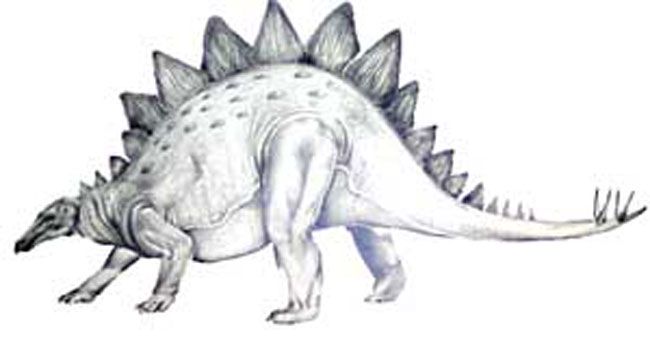Stegosaur Spikes Just for Looks, Dino Experts Say

Scientists sometimes gravitate to the strange even when simpler explanations are available. Take the Stegosaurus, for example, whose spiky outfit was thought by some to be a defensive array.
The plates that lined the backs of this oddly adorned dinosaur may have had no other function than to help them identify each other, like the colorful feathers on birds, scientists said today.
Stegosaurs lived during the Jurassic period, about 210 to 144 million years ago. The most recognizable species, Stegosaurus stenops, was 20 feet long and had rows of plates down its back. Other stegosaurs had spikes instead of plates, or a combination of the two.
A team of paleontologists has analyzed plates from the fossil record, ruling out some of the previous explanations given for this distinctive feature.
"When people see bizarre structures, they always want to give them bizarre functions," said Russell Main from Harvard University.
The bony plates, called scutes, had been thought to protect these herbivores from attacks from predators like the ravenous Allosaurus, but the fin-shaped appendages apparently would not have been strong enough for the job.
"These plates wouldn't offer much protection - they consist of a layer of dense bone surrounding a latticework of bone that would be like biting through a sandwich," said Kevin Padian of the University of California, Berkeley.
Sign up for the Live Science daily newsletter now
Get the world’s most fascinating discoveries delivered straight to your inbox.
Not that dinosaurs couldn't make protective gear. The ankylosaurs had club-like tails that were light and strong as a surfboard or bulletproof vest, a recent study found.
Another theory had the plates acting as heat exchangers, like the ears of an elephant. On hot days their large surface area could have radiated heat away to cool the beast. This hypothesis was justified by the existence of large blood vessels that left tracks through the bone.
But the new study found that the blood vessels were all dead ends, which argues against thermoregulation.
Large vessels are common in the horns and antlers of many living animals. These skull appendages are not meant for heat exchange - the big "pipes" instead supply the blood needed for fast growth. This may be the reason for stegosaurus' large vessels, as well.
The researchers argue that stegosaur plates served no other purpose than to tell species apart. Other peculiar dinosaur adornments - like the horns of triceratops, the domes of the pachycephalosaurs, and the crests of the duck-billed hadrosaurs - may also fall into this category of mere decoration.
The results will be published in the spring issue of the journal Paleobiology.
Related Stories













